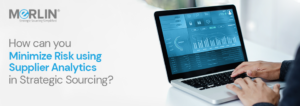Supplier Relationship Management is a systematic approach to evaluate the supplier’s contribution to your business. You identify, select and manage the suppliers you do business with. It is a form of discipline that helps to determine the value each supplier brings to the business. It serves as a pillar for collaboration amongst procurement and supply chain management professionals. SRM is a key pillar of procurement that helps in managing and yielding the most value from business relationships. It is a process that involves coordination of the business with an external party to obtain maximum benefits.
SRM helps to develop positive relationships between your suppliers. Especially with the ones that are considered strategic associations for the company brand. And having strategic relationships with the suppliers comes with several perks:
- Best price and value for needed products and services
- Become the preferred customer for the suppliers- first to be served
- Reduces time to market
- Mutual profitable growth
- Common operating framework for all development work
Many businesses depend on multiple suppliers to source everything from product components to basic stationery. So, it would make sense to have a strategy to segment these suppliers to determine the important categories of purchase. The idea behind this is to differentiate the suppliers in order to identify the opportunities and risks involved with onboarding each supplier. Of course, there is a certain amount of risk that’s inevitable. But once you know what kind of risk you are dealing with; you can develop a proactive strategy to deal with the suppliers in such a way that the results are optimal. Hence, it is important to have an effective supplier sourcing strategy in place.
Inhaltsverzeichnis
ToggleThe Supplier Lifecycle
The procurement process has two aspects at heart- the need for resources and the suppliers, demand and supply. With the growing need for resources, there will be a rise in the number of suppliers who can satisfy that need. And with that many numbers of suppliers, it is important for the business to choose the most suitable vendor that best meets the business needs. This means businesses have to scrutinize suppliers to find the best supplier who offers the maximum value. Procurement experts will have to do their due diligence before they decide to onboard a supplier. And it doesn’t end there. You need to put that alliance into paper through a contract, ensure they are consistent with their offerings to the business, understand the risks of taking them on, make sure they are giving you the best price for their resources, the list goes on. So, to break it down here’s how a supplier lifecycle looks like:
Supplier Qualification
The cycle begins here. The need of the business is defined. So, the next step is to understand who all can meet the needs. Organizations advertise their requirements and suppliers who feel they can meet their requirements are invited to register.
Supplier Evaluation
The registered suppliers are assessed. The ones who do not qualify to meet the criteria are eliminated. The manner of evaluating the suppliers depends on the business.
Selection
After assessing and shortlisting the most suitable vendors, the next step is to select a supplier that has the capability of sustaining a long-term relationship. When it comes to relationships, you should definitely go the distance.
Lieferanten-Onboarding
Now that the assessments and the right supplier is chosen, all that’s left is to formally welcome them on board. Suppliers go through the documentation process that includes the requirements, delivery schedules, payment details, etc so that there is a legal binding of the relationship.
Supplier Performance Monitoring
Businesses need to monitor the suppliers and ensure that they are contributing whatever they offered to contribute. And the monitoring needs to be done in each stage, from the point of purchase till the time the resources are delivered.
Supplier Risk Management
Risk management is important because the business needs to be protected in case of breach of contract by the suppliers or any of the terms that are agreed upon. A supplier risk assessment is an audit of a vendor’s processes, policies, and financial health to determine how much risk it poses to the organization. Some of the risks that need to be looked at in the assessment process include:
- Regulatory risk– The risk of non-compliance with the regulatory requirements or the commercial undertakings associated with sourcing, outsourcing, or offshore arrangements in the jurisdictions that you operate.
- Commercial risk– The risk of financial loss or cost overruns from improper management of sourcing arrangements or supplier failures and inaccurate invoicing.
- Reputational risk– The risk to your organization’s reputation due to a service or supply’s interruption, quality failure, or even a supplier’s business practices.
Supplier Development
Supplier development is the process of collaborating with suppliers to improve their processing and manufacturing capabilities. Suppliers should be viewed as strategic partners with ongoing relationships. The focus should be on continuous improvement to ensure the manufacturers in your supply chain meet the needs of your organization in the future. By doing this you can accomplish goals such as maintaining the lowest possible costs, minimizing product defects, and ensuring on-time shipments. The supplier development process will differ for organizations, but some essential steps for an effective supplier sourcing strategy are:
- Complete a needs analysis– The first step in solving a problem is recognizing there is one. The need analysis helps you assess the current situation of your suppliers. Understand what your supplier’s needs are before you address them.
- Supplier rating using KPI’s– Having chosen your KPI’s, it is important to rate the suppliers on those KPI’s. Then address the issues based on urgency. Issues like inconsistent delivery need to be addressed immediately.
- Plan for addressing the issues– With all the key issues identified, there should be an approach to address these deficiencies. This can be done with the help of training sessions or by defining new processes to address the issues.
- Implement the plan- Implement the course of action and monitor the KPI’s to see if the metrics are improving.
Supplier Relationship Management
After the performance and risk assessments, you feel that the supplier is worth having a long relationship with, you should continue to invest with them in the future. Thus, Supplier Relationship Management should go beyond a single contract and extend to building a long and sustainable relationship between the buyer and supplier to form a strategic partnership.
How can a Strategic Sourcing Solution Help with Supplier Relationship Management?
All in all, when it comes to Supplier Relationship Management, a business will need a platform providing a comprehensive view of all vendor-related data and allows managing the end-to-end supplier lifecycle. You will be equipped with the analytics tools that help you get a comprehensive view of supplier information. So, what are the benefits that can be expected from using Strategic Sourcing Software to manage your suppliers?
Supplier Lifecycle– An end-to end approach used to manage external vendors in a transparent, organized and integrated way, right from on-boarding to off-boarding. In the end, suppliers remain at the heart of the sourcing function. Recognise what value each supplier brings to the table and strengthen your alliance with that supplier who constantly uplifts your performance.
Supplier Performance Management– Monitor the supplier compliance requirements for different supplier categories or groups based on business rules. Identify the weak spots of the suppliers, continuously drive improvement, cut costs and strategize to alleviate risks. Evaluate your suppliers against organisational performance benchmarks, view supplier ratings and review process to ensure uninterrupted quality supply of resources from your supply base.
Intelligence and Analytics– Monitor and analyse supplier KPI’s. Improve decision making by assessing how much risk the business is exposed to, by onboarding each supplier. A solution like MeRLIN helps you gain insights to monitor spend and mentor the preferred suppliers, being the ideal vendor management system.
MeRLIN offers a comprehensive solution that streamlines Supplier Relationship Management. It offers a unified view of all supplier related information and simplifies supplier data management. Its intuitive interface makes it easy for suppliers to self-register and the rule-based approval process significantly speeds up the onboarding process, saving time and reducing errors. MeRLIN supplier performance management features and supplier intelligence allows organizations to measure, evaluate and track supplier performance as well as gain actionable insights to monitor spend, identify preferred suppliers, mitigate supply risks and drive continuous improvement. Manage your risks, manage your compliance but most of all manage your supplier relationships. Kontaktieren Sie uns to know more.






